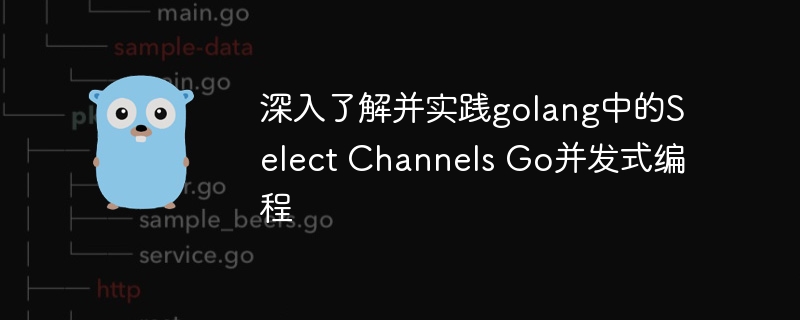Home >Backend Development >Golang >In-depth understanding and practice of Select Channels Go concurrent programming in golang
In-depth understanding and practice of Select Channels Go concurrent programming in golang
- WBOYOriginal
- 2023-09-28 12:13:06987browse

In-depth understanding and practice of Select Channels Go concurrent programming in golang
Introduction:
In today's software development field, high concurrency is a Very important topic. As an open source programming language, Go language performs well in handling concurrent programming through its simplicity, efficiency, and strong concurrency. Among them, Select Channels is a very useful concurrency model in the Go language, which gives full play to the advantages of concurrent programming in the Go language. This article will introduce the principles and practical applications of Select Channels in depth, and provide some specific code examples.
1. What is Select Channels
In concurrent programming, we often need to handle multiple communication operations at the same time. The Go language provides a concise and efficient way to handle this situation, namely Select Channels. The Select statement can monitor the operations of multiple channels at the same time and perform corresponding operations when any one of the channels is ready.
Specifically, the Select statement contains a series of Case clauses. Each Case clause corresponds to a channel operation (send or receive), and they will be evaluated sequentially from top to bottom. When one of the Case clauses is ready, the corresponding operation will be executed and the Select statement will terminate. If multiple Case clauses are ready at the same time, the Go language will randomly select one of them for execution.
2. Usage of Select Channels
Below we show the usage of Select Channels through several specific examples:
- Single channel:
package main
import "fmt"
func main() {
dataChan := make(chan int)
doneChan := make(chan bool)
go func() {
for {
select {
case num := <-dataChan:
fmt.Println("Received data:", num)
case <-doneChan:
fmt.Println("Done")
return
}
}
}()
dataChan <- 1
dataChan <- 2
dataChan <- 3
doneChan <- true
}In the above code, we created a data channel dataChan and an end channel doneChan. In the main function, we start a goroutine to monitor channel operations. When the data channel dataChan receives the data, we print it out and continue to listen; when the end channel doneChan receives the message, we terminate the monitoring.
- Multiple channels:
package main
import (
"fmt"
"time"
)
func main() {
dataChan := make(chan int)
doneChan := make(chan bool)
go func() {
for {
select {
case num := <-dataChan:
fmt.Println("Received data from dataChan:", num)
case <-time.After(time.Second * 2):
fmt.Println("Timeout")
case <-doneChan:
fmt.Println("Done")
return
}
}
}()
dataChan <- 1
time.Sleep(time.Second * 3)
doneChan <- true
}In the above code, we added a timing channel time.After to achieve the timeout effect. When the dataChan receiving data does not receive data within 2 seconds, we will print out the Timeout.
3. Practical application of Select Channels
Through the above examples, we can see some basic usage of Select Channels. Below, we will analyze several common scenarios in practical applications:
- Timeout processing:
In network programming, we often need to set a timeout period to Protect the system from prolonged congestion. By adding the timing channel time.After in Select Channels, we can implement a simple and elegant timeout handling mechanism.
- Multiplexing:
In high concurrency scenarios, we may need to monitor the operations of multiple channels at the same time, such as processing user requests and sending requests to other channels at the same time. Services etc. Through Select Channels, we can easily multiplex and avoid cumbersome conditional statements and lock mechanisms.
- Exit mechanism:
When using goroutine to handle concurrent tasks, we often need a mechanism to exit gracefully. We can achieve this by adding an end channel to Select Channels. When the end channel receives a message, we can clean up the resources and terminate the goroutine's execution.
4. Summary
By in-depth understanding and practice of Select Channels, we can discover its importance and advantages in concurrent programming. Its simplicity and efficiency make concurrent programming more convenient and reliable. In daily development, we should make full use of this feature and rationally apply Select Channels to improve the concurrent processing capabilities of the program.
This article introduces the principles, usage and practical applications of Select Channels through specific code examples. With an in-depth understanding and practice of the Go language, I believe we will be able to use this concurrency model more skillfully and give full play to its advantages in high-concurrency scenarios. In future development, it is our constant pursuit to continuously explore and apply new technologies and improve our own programming level.
Reference:
- A Tour of Go: Select
https://tour.golang.org/concurrency/5 - Effective Go: Concurrency
https://golang.org/doc/effective_go#concurrency - Go language Chinese website
https://studygolang.com/
The above is the detailed content of In-depth understanding and practice of Select Channels Go concurrent programming in golang. For more information, please follow other related articles on the PHP Chinese website!

